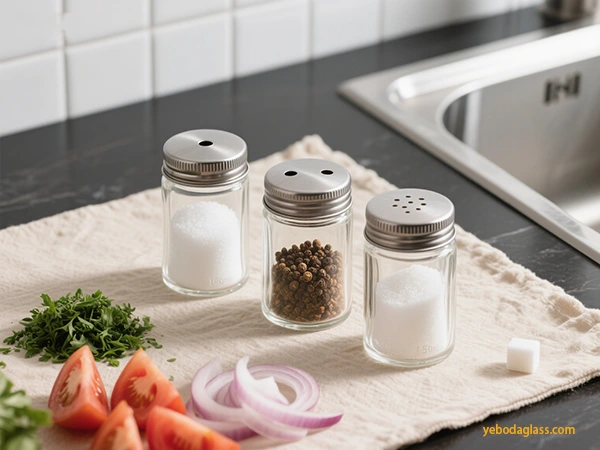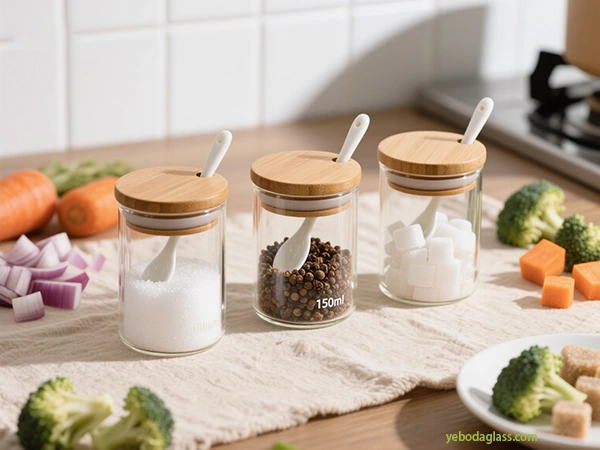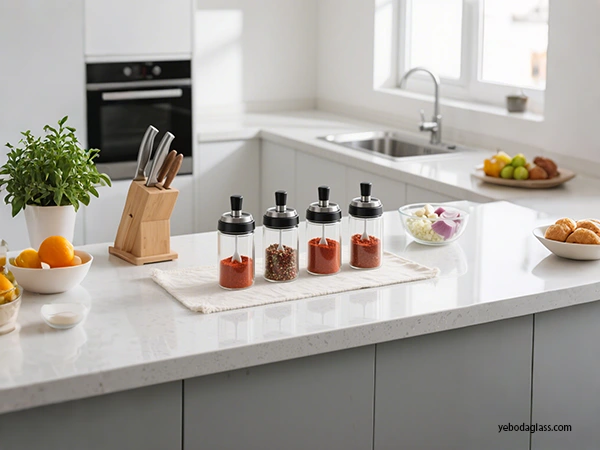giriiş
In today’s competitive global market, packaging is more than a container – it is a brand ambassador. For businesses in the Spice Industry, Glass Spice Jars play a decisive role in shaping the brand image, ensuring freshness and affecting purchasing decisions. This report provides wholesale buyers with a broad roadmap for durable, adaptable and cost -effective glass spice jars. Ultimately, the right sourcing strategy converts packaging into a competitive advantage. By aligning with manufacturers connecting scalability, quality and customization, wholesale traders can protect product integrity by increasing their market appearance. Evet, evet. glass spice jar represents an example of packaging excellence that combines stability, clarity and brand-growing aesthetics.

Wholesale Order Volume & Scalability Analysis
Evaluating Supplier Capacity
Understanding order volume requirements is the foundation of wholesale sourcing. Buyers must clearly define expected volumes—whether 5,000 units for small-batch spice startups, 50,000 units for growing brands, or 200,000+ units for multinational distributors. Suppliers must prove they can adapt to scaling demand without compromising quality. This scalability ensures long -term partnership stability and reduces the risk of stockouts or expensive delays. At the end of this evaluation, Yeboda’s glass spice jars stands out because the company maintains a balance of strong production capacity and adaptation support, making it suitable for scaling businesses from regional to global markets.
MOQ Interaction and Production Efficiency
Minimum order volume (MOQ) directly affect bulk feasibility. While some suppliers demand MOQs as high as 50,000 units, flexible suppliers can reduce MOQs to 2,000-5,000 units, which can enable market testing before scoring large scale runs. Skilled mold use and lean production processes are important in keeping the amoQ manageable. Negotiating MOQs should include discussions on unit price scaling, storage agreements, and phased delivery models. For instance, Beausino accommodates MOQs of 10,000 units for custom molds but allows phased shipments over 6 months. Buyers benefit from analyzing long-term demand projections to secure better MOQ terms without overburdening storage capacity. Suppliers who optimize efficiency while maintaining consistency build trust with B2B buyers. This flexibility is particularly valuable for emerging spice brands experimenting with product lines. Yeboda’s cam kavanozlar provide this adaptability, offering high-quality jars even at moderate MOQs while supporting large-scale scalability when demand increases.
Long-Term Scalability Considerations
Beyond initial volumes, businesses must prepare for scaling to regional or global distribution. Suppliers with robust infrastructure, such as multiple production lines and automated QA processes, can handle exponential demand growth. It is also critical to assess whether suppliers maintain redundant facilities to mitigate risks of disruption. Global buyers should also evaluate shipping logistics: with the partnership of installed goods, the supplier near the major ports can speed up the scaling by reducing the cost. Additionally, the scalable supply chain should include flexible warehousing solutions and just-in-time inventory management. A supplier’s ability to grow with its customers ensures that packaging does not cause a development bottleneck. It separates strategic partners from suppliers of long-term vision transactions. Yeboda’s glass spice jars have been deployed to serve this scalability, which offers a reliable route from boutique order to multinational distribution.
Jar Specifications and Design Ideas
The second column of sourcing strategy lies in the physical design and functional characteristics of the glass spice jars. Beyond storage, the jar must increase the consumer purpose, maximize the shelf appeal, and reflect brand values.
- The shapes range from cylindrical and square to hexagonal and thin vertical forms. Cylindrical jars are versatile, while square jars provide labeling efficiency and space adaptation. Hexagonal designs add premium aesthetics, attracting gap consumers. The size is usually ranging from 2oz to 16oz bulk jar for food service for special spices.
- The selection of glass type also matters. Soda-Lime Glass dominates due to strength and clarity, while borosilicate glass provides the thermal shock and increased resistance to chemical corrosion, making it suitable for premium spice collection. Brands should weigh cost against performance, align the choice of materials with brand positioning.
These ideas turn packaging into a brand property. By offering clarity, strength, and adaptable molds, the glass spice jars of the Yeboda allow buyers to attack the correct balance between practicality and premium aesthetics, which strengthens the perception of the brand in the point-off-cell.

LID and Closure System Requirements
No matter how durable the jar is, the effectiveness of the glass spice jar depends on the lid performance. Lids products maintain integrity, prevent contamination, and increase the purpose.
Available closure systems include:
- Airtight screw-tops (metal or plastic) for preserving volatile oils.
- Shaker tops for convenient dispensing of fine spices.
- Pour spouts for coarse spices or blends.
- Eco-friendly bamboo lids for sustainable branding.
Compatibility testing between jars and lids is essential to avoid leaks or misfits. Packaging functionality must reflect the consumer’s end use: gourmet kitchens demand airtight precision, while casual users may prefer simple flip-top convenience.
Effective lid systems elevate customer satisfaction, reduce spoilage, and align with branding. By offering multiple lid configurations, Yeboda’s glass spice jars deliver both preservation and convenience, positioning them as versatile solutions for wholesale buyers across diverse market segments.
Global & Regional Supplier Landscape
The international glass spice jars supply chain spans Asia, Europe, and North America. Each region offers distinct strengths:
- China: Competitive pricing, large-scale capacity, and flexible customization. Prominent players include Roetell, Beausino, and Feemio.
- Avrupa: Advanced manufacturing technology, stability leadership and heritage expertise. Notable Suppliers: Verlia, Ardag Group, Greshhememer.
- Kuzey Amerika: Strong compliance focus, proximity benefits for American buyers, and major company Owens-Illinois.
Buyers should weigh cost savings against stability standards, lead time and import complications. Accountability, certificate and production are essential among partners evaluating transparency. The glass spice jars of the yeboda, manufactured with rigid qa and durable practices, simulate the quality and ability of a balanced sourcing solution.
Cost Analysis and Price Adaptation
Glass spice jars produces cost efficiency in sourcing by balanceing raw material expenses, adaptation fees and logistics. Soda-Lime Glass remains cost-effective, while borosilicate increases the premium cost, but supports high-margin products. Custom mold fees ranges from $ 5,000 to $ 10,000, with long -term refinement signatures perfect investment for signature design. Energy-intensive melting processes contribute significantly to volatility in value, especially in Europe where the cost of energy fluctuates. Shipping also increases expenses; Container freight rates may double in the peak season, which affects the landed cost per unit. Strategic buyers consolidate shipments, interact on phased delivery, and take advantage of multi-year contracts to stabilize pricing. The adaptation of packaging design to reduce material use further enhances the cost competition.

Stability and Quality Assurance Protocols
Quality assurance for glass spice jars are paramount. The durability test ensures thermal shock, mechanical effects and jars with long distance transit. Standards such as ASTM C147 install benchmarks for the strength of internal pressure. Manufacturers appoint anneal to increase stress and tempering to increase strength. Chemical analysis confirms food-grade compliance, ensuring that jars do not bite harmful substances. Consistency in the thickness of the wall prevents weak points and ensures uniform sealing. Reliable suppliers maintain rigid batch test, reject defect rates above 2%, and employ automatic inspection systems. These measures not only protect product integrity, but also protect the brand reputation.
Supplier Vesting & Desigence Framework
Constated veting is required to select wholesale partners. Buyers should evaluate:
- Certificate: ISO 9001: 2015, FDA, ROHS, access.
- Financial stability: Credit rating and Altman Z-Schor.
- Labor Ethics: Compliance with Global Labor Standards.
- Hesap verebilirlik: Zamanında teslimat%, yanıt süresi%2 saat.
Third-party verification services and suppliers audits reduce the risk of misinformation. Trusted suppliers provide transparent documentation and reference from installed buyers.
Logistics, Packaging and Supply Strategies
Skills reduce transit damage and optimize costs. Packaging should employ cushioning, dividers and double-boxing for delicate glass spice jars. For e-commerce, packaging should tolerate multiple handling stages. Shipping models include LTL (less than truck load) for frequent small batches and FCL (full container load) for consolidated bulk order. Customs compliance, duties and tariffs should be factor in the cost calculation of land. Renting of licensed brokers reduces withdrawal risks. Buyers get competitive benefits by mastery in total cost optimization and by aligning logistics with global demand cycles.
Emerging Trends and Innovative Sourcing Solutions
Glass spice jars industry are developing with stability and smart technology. Major trends include:
- Recycled materials: Including PCR glass to reduce carbon footprint.
- Lightweight: Losing weight to save energy and shipping costs.
- Hybrid furnaces: using electric and renewable energy to melt greenery.
- Smart Packaging: QR code for traceability, sensor for freshness monitoring.
Innovative sourcing models, such as direct-to-factory digital platforms, are re-shaping the purchase. These glass spice jars of Yeboda aligns with these trends by combining quality, adaptation and environment-conscious practices, making them a strategic option for buyers who forward them.

Strategic Recommendations and Conclusions
For wholesale buyers, source of glass spice jars are decision that affects brand image, customer satisfaction and operating efficiency. Businesses need:
- Define the clear order volume requirements and assess the supplier scalability.
- Consumer preference the design and closure system aligned with expectations.
- Evaluate global suppliers on cost, compliance and stability.
- Apply a strong veating framework to secure long -term partnership.
- Adapt logistics to reduce breakdown and reduce landed costs.
- Embrace stability and innovation as discrimination.
By integrating these strategies, the wholesalers ensure that their packaging costs the brand equity by controlling the cost. With durability, flexibility and designs prepared for the market, Yaboda’s glass spice jars represents a benchmark in a balanced function and branding, providing wholesale buyers a reliable route for long -term success.




